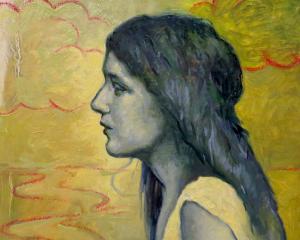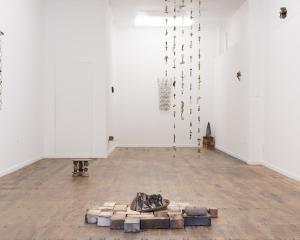
(DPAG)
The Gift (2021), a large scale, three-channel film by Slovenian-born, London-based artist Jasmina Cibic, is an artwork that is good to think with. The Gift’s conceptual tension centres on the redeployment of historical, political documents (transcripts, letters, records) as dialogue uttered by the film’s characters to address contemporary issues of the nation state and global conflict. The easy transference of archival documentation to the present, evident in lines such as "civilisation drifting towards the abyss", "our gift should stem from our struggle for freedom," and "a perfect gift for our divided nation", is perhaps less the conceptual tension proposed earlier and more of a continuing operative mode. It is perhaps a magical, amnesiac desire to expect a progressive present-becoming-future different from autocratic pasts left behind.
Set in monumental buildings that were political gifts — the French Communist Headquarters, the Palace of Nations in Geneva, and the Palace of Culture and Science in Warsaw — the film follows the attempts of an artist, a diplomat, and an engineer (all male) as they individually present their proposals for the perfect gift to a panel of four judges (all female). Through set design in both brutalist and opulent architectural built environments and via 1970s dress and makeup, Cibic’s vintage style choices intentionally distort timelines to underscore both the repetitive tendencies of history and the urgency of addressing the unregulated technological mechanisms that enable disinformation to thrive.
In Aotearoa and in other islands and continents that were colonised in the last several hundred years, the nation state itself is, of course, an imposition.

(Blue Oyster)
The excerpt that accompanies Otautahi Christchurch-based artist Sam Clague most frequently positions his work in terms of "elision" and "aporia." Elision describes the act of diminishing or stripping back, and aporia is another way of saying absence. Yet even as both words signify excavation they also hold on to some sense of presence. Shallow sand ridges are made by waves; the elision or aporia of the waves have nevertheless imprinted themselves on the sand. Something is left behind, something is still there, but its presence might take the form of an imprint. By framing his practice between here and not here (or here less, and perhaps in a different form), Clague encourages the viewer to similarly expect the bones of an aftermath, or what remains. It is a Warholian type of strategy by which the artist foregrounds their "knowingness" or potential sleight of hand.
Viewing Clague’s installation artwork is a dislocating experience torqued with flashes of semantic, visual, and kinetic brilliance. The dislocation stems from multitudinous references to the practices of other contemporary artists collected together in a single artwork or installation. There are continual moments of deferred recognition whereby reiterated deployments of materials, found objects, aesthetics of conjunction (joining together seemingly disparate, often found objects) and separation point towards x artist only to veer away towards y artist.
One of the notable elisions and aporias (true absence) of The Company is Clague’s figurative and/or text-inclusive paintings. In the context of imperial- to corporate-era capitalism indexed in this exhibition, it is interesting to consider whether re-tooling the tools destabilises the master’s house.

(Olga)
Brains with faces, flawed families, smoking dogs, self-portraits, and Liz (Queen Elizabeth II), the Rayner Brothers are back for another outing at Olga with their slightly outre ceramics. This time the "Circus" features Otepoti Dunedin-based artist Jay Hutchinson’s well-known embroidered works of found rubbish (screen-printed on to fabric and embroidered).
With more than a nod to the recently deceased Queen, Olga exhibits four ceramic statues of Liz wearing a bright yellow dress, hat, handbag, and pearl earrings by Mark Rayner, and one statue by both Mark and Paul Rayner. This collaborative work is the last in a semantic-physical transformation in which Liz becomes part lizard, with a yellow skirt her last human vestige. The other contemporary event Mark Rayner addresses is the monkey pox virus (a monkey covered in red spots). Perhaps also afflicted with monkey pox is the endearingly-titled Sad Orange Crystal Boy (2022), a hairless boy-man with big ears, a wide-mouthed smile, baby blue eyes, and yes, predominantly red spots on his torso and face. Both brothers present several self-portraits wearing t-shirt with slogans, while Paul Rayner also offers three Jesus Saves money boxes in time for Christmas.
Exhibited among this melange of troubled and cheerfully perverse characters are Hutchinson’s embroidered works in clear frames. Perhaps there are less Jimmy’s pie bags around at this time of the year, as Hutchinson has shifted his focus to lolly wrappers (Fruit Bursts and Milkshakes), a Rashuns bag, and the ultimate hint of summer, a Fruju wrapper. Insert summer jingle and check it out.








![Rozana Lee, "Drawn to see(a)" [Installation view]. Photo: Beth Garey](https://www.odt.co.nz/sites/default/files/styles/odt_landscape_small_related_stories/public/story/2024/10/blue_oyster_r_lee.jpg?itok=IGhlKMSl)



![Phaeacia (2024), by Paul McLachlan [detail]. Acrylic and rust on canvas.](https://www.odt.co.nz/sites/default/files/styles/odt_landscape_small_related_stories/public/story/2024/09/paul_mclachlan_phaeacia_de.jpg?itok=UuQsvnQc)